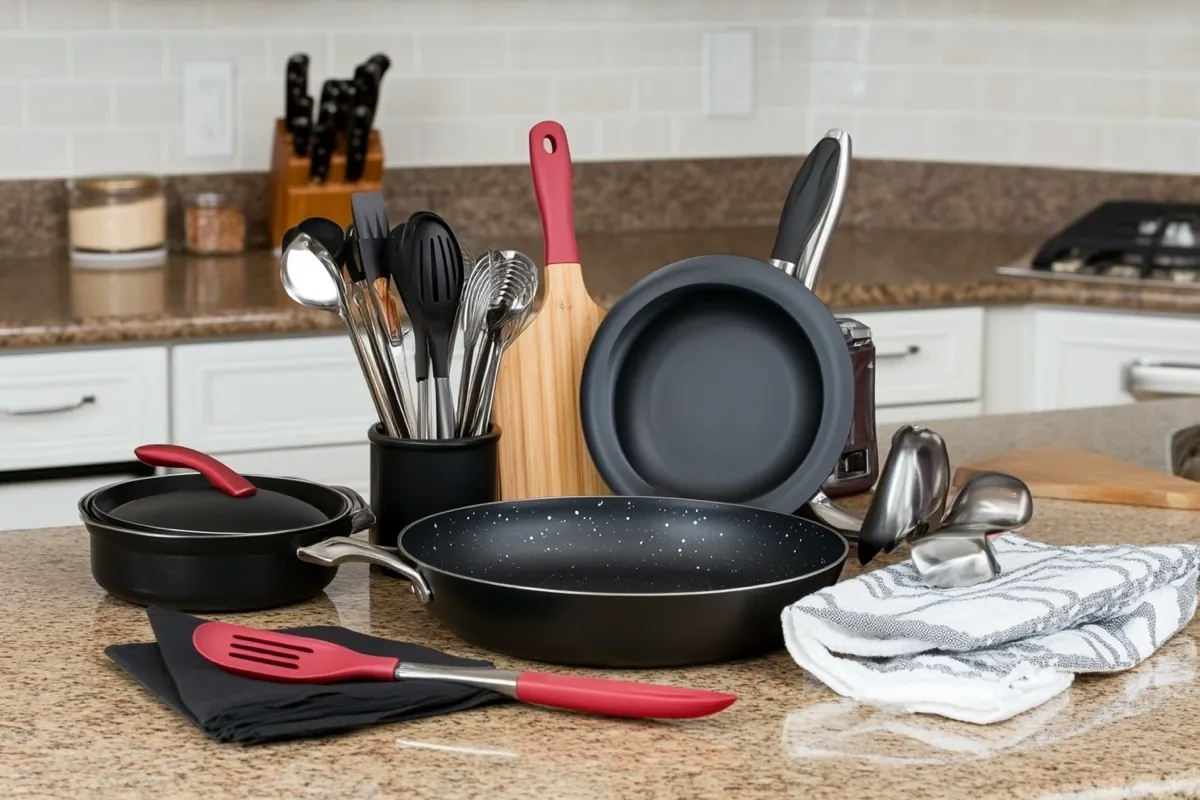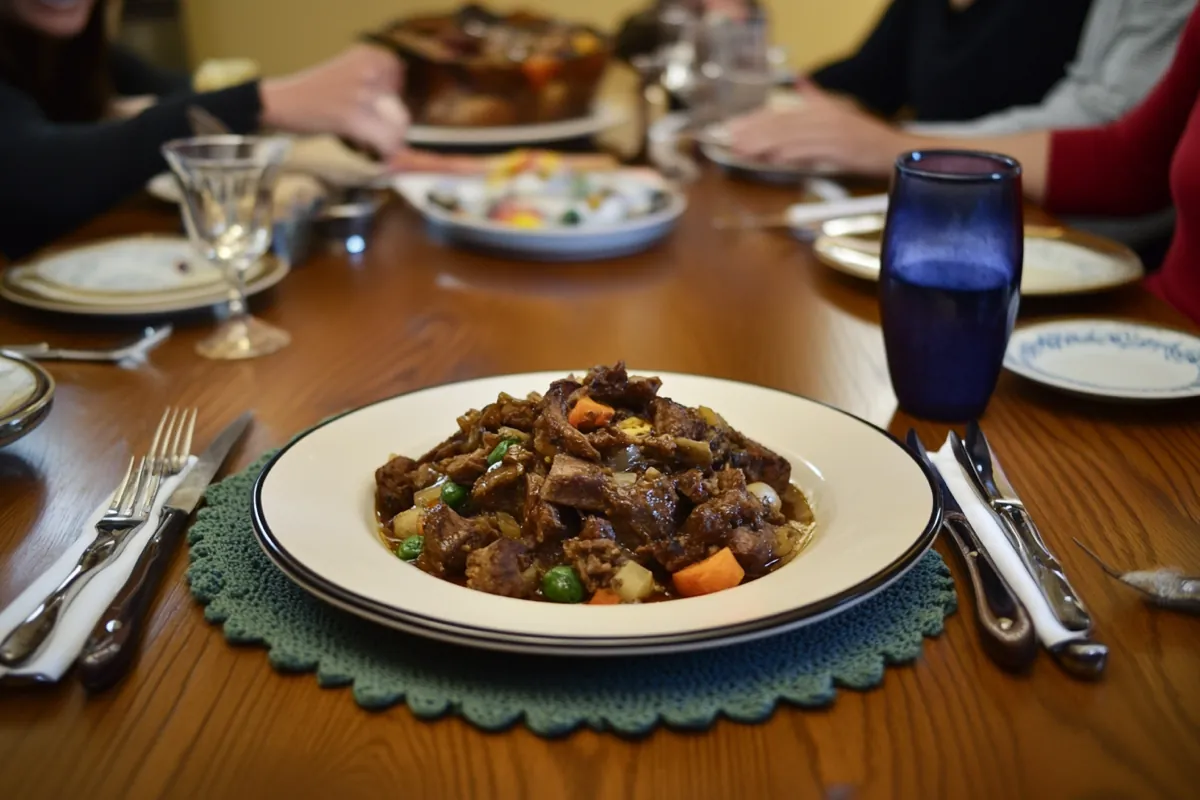If you’re looking for a cooking method that combines flavor and simplicity, look no further than pan roast. This technique allows you to achieve a deliciously crispy exterior while keeping the inside succulent. Whether you’re cooking meat or seafood, pan roasting is versatile and easy to master. In this comprehensive guide, we’ll explore the essence of pan roast, compare it to gumbo, and provide you with a seafood recipe that will impress your guests.
Table of Contents
What is Pan Roast?
Pan roasting is a cooking method that combines both searing and roasting. It starts on the stovetop, where ingredients are browned in a pan, followed by finishing in the oven. This technique allows for deep flavor development and even cooking. It’s a favorite among chefs and home cooks alike for its ability to deliver restaurant-quality meals.
Definition and Cooking Method
At its core, pan roasting involves cooking food in a heavy skillet or roasting pan. The process usually begins with high heat to create a seared crust, which locks in moisture and enhances flavor. After searing, the heat is reduced or transferred to the oven, allowing the food to cook through without drying out. This method is perfect for beef, chicken, vegetables, and seafood, making it incredibly versatile.
History and Origin of Pan Roast
The origins of pan roasting can be traced back to various cooking traditions around the world. It has roots in both European and American cuisines, where cooks learned to maximize flavor by using available resources. As cooking techniques evolved, pan roasting became a staple method due to its efficiency and ability to produce rich, complex flavors.
Cultural Significance
In many cultures, pan roasting holds a special place in culinary traditions. For instance, in Italian cuisine, the method is often used to prepare classic dishes like osso buco. Similarly, in American households, pan roasting is a weekend favorite, allowing families to gather around the table to enjoy hearty meals. Its adaptability is what makes pan roasting so significant in diverse culinary practices.
Pan Roast vs Gumbo: Key Differences
When comparing pan roast vs gumbo, it’s essential to understand their distinct characteristics. Both dishes offer unique flavors and cooking experiences, but they cater to different tastes and occasions.
Flavor Profiles and Ingredients
Pan roast typically features a crispy exterior and a tender interior, emphasizing the natural flavors of the main ingredient. Common ingredients include beef, chicken, seafood, and seasonal vegetables. On the other hand, gumbo is a rich, stew-like dish that blends various flavors from spices, vegetables, and proteins, often served over rice.
Cooking Techniques
The cooking techniques also differ significantly. Pan roasting involves searing and then roasting, allowing for precise temperature control. Gumbo relies on slow cooking, where ingredients simmer together, allowing flavors to meld. This method requires more time but yields a comforting and hearty dish.
Regional Variations
Both dishes have regional variations. For instance, pan roasting can include different herbs and spices depending on the cuisine. Gumbo, primarily a dish from Louisiana, varies widely based on local ingredients and traditions. Understanding these variations can enhance your cooking experience.
When to Choose Pan Roast Over Gumbo
Choosing between pan roast and gumbo often depends on the occasion. If you’re looking for a quick and elegant meal, pan roasting is the way to go. However, if you’re hosting a gathering and want something comforting, gumbo might be the better choice. Knowing when to use each method can elevate your cooking game.
The Perfect Pan Roast Recipe: Seafood Edition
Now that you’re familiar with pan roasting, let’s dive into a delectable pan roast recipe seafood that you can easily recreate at home. This recipe is not only flavorful but also showcases the versatility of pan roasting.
Ingredients for Pan Roast Recipe Seafood
To get started, you’ll need the following ingredients:
- 1 pound of fresh seafood (such as shrimp or scallops)
- 2 tablespoons olive oil
- 1 teaspoon garlic, minced
- 1 teaspoon lemon zest
- Salt and pepper to taste
- Seasonal vegetables (like asparagus or bell peppers)
Step-by-Step Instructions
Preheat Your Oven: Start by preheating your oven to 400°F (200°C).
Prepare the Seafood: In a bowl, mix the seafood with olive oil, garlic, lemon zest, salt, and pepper. Ensure that everything is well-coated.
Sear the Seafood: Heat a large oven-safe skillet over medium-high heat.

Essential Tools and Equipment for Pan Roasting
Having the right tools is crucial for successful pan roasting. The equipment you choose can significantly impact the outcome of your dish. Here’s what you need to ensure a seamless cooking experience.
Must-Have Cookware
Heavy-Bottomed Skillet: A good-quality, heavy-bottomed skillet is essential for even heat distribution. Look for materials like cast iron or stainless steel, which can withstand high temperatures.
Oven-Safe Pan: If you plan to finish your cooking in the oven, make sure your skillet or pan is oven-safe. This allows you to transfer directly from stovetop to oven without missing a beat.
Roasting Pan: For larger cuts of meat or multiple servings, a roasting pan is ideal. It provides ample space for roasting and can catch drippings for sauces or gravies.
Lid or Foil: Having a lid or aluminum foil is helpful. These can be used to cover the pan during cooking, ensuring moisture retention and enhancing flavor.
Recommended Utensils
Spatula: A sturdy spatula is vital for flipping and turning your food without damaging it. Choose one made from heat-resistant material, like silicone or wood.
Tongs: Tongs are perfect for handling seafood or vegetables without piercing them, helping to maintain their shape and juices.
Meat Thermometer: A reliable meat thermometer is crucial for ensuring your meat is cooked to the right temperature. This helps avoid undercooking or overcooking, guaranteeing a perfect pan roast every time.
Basting Brush: A basting brush is handy for applying marinades or oils during the cooking process. Keeping your food moist enhances its flavor and texture.
Pan Roast Variations: Beyond Seafood
While seafood is a fantastic option for pan roasting, there are numerous variations you can explore. Let’s look at different types of pan roasts that cater to various tastes and dietary preferences.
Meat-Based Pan Roast Recipes
Chicken Pan Roast: Using skin-on chicken thighs or breasts is ideal. The skin crisps up beautifully, and the meat remains juicy. Season with herbs like rosemary or thyme for added flavor.
Beef Pan Roast: For beef, choose cuts like ribeye or sirloin. Searing the meat first adds depth of flavor, while finishing in the oven ensures a perfect medium-rare.
Lamb Pan Roast: Lamb chops are another excellent choice. The rich flavor pairs well with garlic and mint. Sear them to create a crust before transferring to the oven.
Vegetable and Vegan Options
Root Vegetable Roast: A mix of root vegetables such as carrots, potatoes, and onions makes for a hearty side dish. Toss them in olive oil and herbs before roasting for a delightful blend of flavors.
Stuffed Peppers: Bell peppers stuffed with grains, beans, and spices can be pan roasted for a nutritious vegan meal. They cook through and develop a lovely charred flavor.
Mushroom Roast: Large portobello mushrooms can be seasoned and roasted for a meaty texture. They absorb flavors well and can be served as a main dish or in salads.
Flavor Enhancements
To elevate any pan roast, consider adding flavor enhancers like:
- Fresh Herbs: Incorporate herbs like thyme, rosemary, or parsley for an aromatic boost.
- Citrus Zest: Adding lemon or lime zest can brighten up the flavors significantly.
- Spices: Experiment with spices such as smoked paprika or cumin to add depth.
Complementary Sides
Pair your pan roast with sides that balance the meal. Here are some suggestions:
- Quinoa or Rice: These grains complement the richness of the roast and can absorb the juices.
- Green Salad: A fresh salad with a light dressing can provide a nice contrast to the heavier flavors.
- Roasted Bread: Crusty bread is perfect for soaking up the delicious juices from the pan roast.

Common Mistakes to Avoid When Pan Roasting
While pan roasting is a straightforward technique, there are several common pitfalls that can affect your results. Being aware of these mistakes can help you cook better and achieve the perfect dish every time.
Overcrowding the Pan
One of the most frequent mistakes is overcrowding the pan. When too much food is placed in the skillet, it can lower the temperature, causing steaming rather than searing. This results in food that lacks the desired crispy exterior. To avoid this, always ensure that there is enough space between the pieces of food. If necessary, roast in batches to maintain optimal heat.
Ignoring Temperature Control
Temperature control is crucial in pan roasting. Many cooks make the mistake of starting with too low heat, which can lead to uneven cooking. Begin with high heat to sear the food, then adjust the temperature as needed. This ensures that your food is cooked through while achieving that beautiful golden crust.
Importance of Preheating
Preheating your skillet is another critical step often overlooked. A hot pan is essential for a good sear. Before adding your ingredients, allow your pan to heat for a few minutes. You can test the temperature by adding a drop of water; if it sizzles and evaporates quickly, the pan is ready for cooking.
Pairing Wines and Beverages with Pan Roast
While this section typically discusses wine pairings, we will focus on non-alcoholic beverage options that complement pan roast dishes. Choosing the right drinks can elevate your meal experience, enhancing the flavors of your pan roast.
Best Beverage Choices by Protein Type
Seafood Pairings: For seafood pan roasts, consider pairing them with sparkling water infused with lemon or a citrus soda. The acidity complements the seafood beautifully.
Chicken or Beef: For chicken or beef roasts, herbal teas like chamomile or mint can offer a refreshing contrast to the rich flavors of the meat. Alternatively, a homemade fruit punch provides a fruity balance.
Non-Alcoholic Pairing Suggestions
Herbal Iced Teas: Chilled herbal teas, such as hibiscus or mint, can be a delightful accompaniment to any pan roast. They provide refreshment and cleanse the palate.
Infused Water: Infusing water with fruits like cucumber, lemon, or berries adds a subtle flavor that pairs well with roasted dishes without overpowering them.
Seasonal Pairing Tips
Consider the season when selecting beverages. In summer, lighter drinks like lemonade or iced tea are refreshing. In the colder months, warming beverages like spiced apple cider can enhance the comforting nature of pan-roasted meals.

Resources for Further Learning
If you’re excited to learn more about pan roasting and expand your culinary knowledge, consider exploring the following resources:
Recommended Cookbooks
“The Complete Cooking Manual”: This book covers a range of cooking techniques, including pan roasting, with delicious recipes and tips for every home cook.
“The Art of Roasting”: A dedicated guide to roasting techniques, it provides insights into different methods, flavor pairings, and seasonal ingredients.
Online Tutorials and Courses
Culinary Websites: Many culinary websites offer free tutorials that delve into pan roasting techniques. Check out resources like Ultimate Guide to Pan Roasting Techniques, Tips & Recipes for detailed instructions and video demonstrations.
Cooking Classes: Look for local cooking schools or online classes that focus on roasting techniques. These can provide hands-on experience and expert guidance.
Community and Sharing Experiences
Cooking is often more enjoyable when shared with others. Engage with fellow food enthusiasts to exchange ideas, tips, and experiences related to pan roasting.
Inviting Reader Contributions
We encourage our readers to share their favorite pan roast recipes or variations. What unique ingredients or techniques do you use? Your contributions can inspire others to explore the world of pan roasting.
Social Media and Engagement
Join cooking communities on social media platforms to connect with other home cooks. Share your pan roast creations, ask for advice, and discover new ideas. Following hashtags like #PanRoast can lead to a wealth of inspiration.
Conclusion: Mastering the Art of Pan Roast
Pan roasting is not just a cooking technique; it’s an art that combines flavors, textures, and aromas to create unforgettable meals. With the right tools, an understanding of the process, and a bit of creativity, you can transform simple ingredients into something extraordinary. Throughout this guide, we’ve explored the fundamentals of pan roasting, compared it to other dishes like gumbo, and provided a mouthwatering seafood recipe to inspire your culinary adventures.
Recap of Key Points
- Definition and Technique: Pan roasting involves both searing and roasting, allowing for a flavorful crust and tender interior.
- Comparison to Gumbo: While pan roast highlights individual ingredients, gumbo blends flavors in a comforting stew.
- Essential Equipment: A heavy-bottomed skillet, oven-safe pans, and proper utensils are crucial for success.
- Variations: Explore meat, vegetable, and vegan options to diversify your pan roasting repertoire.
- Common Mistakes: Avoid overcrowding the pan and ensure proper temperature control for optimal results.
Encouragement to Experiment
As you embark on your pan roasting journey, don’t hesitate to experiment. Try different proteins, seasonings, and vegetables to find your favorite combinations. Cooking is all about creativity and adapting to your tastes. The more you practice, the more confident you will become in your skills.
FAQ
As you begin your pan roasting journey, you may have some questions. Here are answers to some common queries about this cooking method.
What does pan roast mean?
Pan roast refers to a cooking technique that combines both stovetop searing and oven roasting. It involves browning food in a skillet over high heat, followed by finishing the cooking process in the oven. This method ensures a flavorful crust while keeping the inside tender and juicy.
Where does pan roast come from?
The concept of pan roasting originates from various culinary traditions around the world. It has roots in both European and American cooking, where cooks learned to maximize flavor using available resources. Over time, it has become a popular cooking method in many cuisines due to its effectiveness and versatility.
What is the difference between pan fried and pan roasted?
The main difference lies in the cooking process and the amount of fat used. Pan frying typically involves cooking food in a larger amount of oil over medium heat, often resulting in a crispy texture but potentially greasier food. In contrast, pan roasting uses less oil and incorporates an oven roasting step, which allows the food to cook evenly with a flavorful crust.
What cut of meat is best for roasting pan?
When it comes to meat, several cuts work well for pan roasting. Beef ribeye or sirloin, chicken thighs, and lamb chops are popular choices. These cuts benefit from the searing process, resulting in enhanced flavor and tenderness. Always choose cuts that can withstand high heat and retain moisture during cooking.




